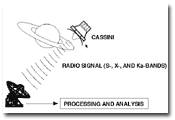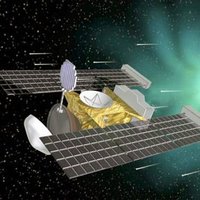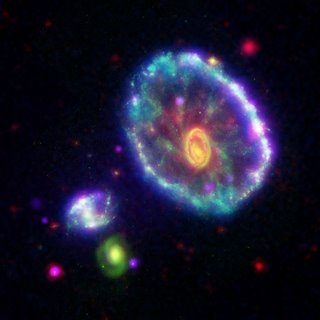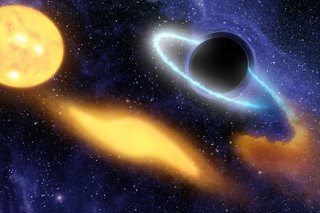Sunday, December 31, 2006
Here is a site that gives accomplishments of the deep space program for 2006. There were some really spectacular discoveries!
Curious about Scientology? Here is an exclusive filmed interview, where L. Ron Hubbard himself answers the most commonly asked questions about Scientology. Now available in a new digitally restored format on DVD and in 50 different languages.
Saturday, December 30, 2006
Friday, December 29, 2006
A good friend died, yesterday. I was greatly comforted by the essay, 'Man's Search for His Soul', in the book Scientology, a New Slant on Life.

Celebrating 2006 accomplishments in space -- Spitzer identified two huge "hypergiant" stars, circled by very large disks of what might be planet-forming dust. It has located coliding galaxies. It has investigated the remnants of supernova (see picture). You can get these and a large number of other very cool images here.
Thursday, December 28, 2006
One reason to have an excellent command of personal communication skills is to conduct good job interviews. I am interviewing someone who wants a position in my organization right now, and it is important for me to help them get past any communication barriers that they might have in order to determine if they have the necessary underlying knowledge and ability to work here. The Success Through Communication course is a good way to gain essential personal communication skills.

Cassini images of Saturn's moon Enceladus backlit by the sun show the fountain-like sources of the fine spray of material that towers over the south polar region. This image was taken looking more or less broadside at the "tiger stripe" fractures observed in earlier Enceladus images. It shows discrete plumes of a variety of apparent sizes above the limb (edge) of the moon.
Imaging scientists, as reported in the journal Science on March 10, 2006, believe that the jets are geysers erupting from pressurized subsurface reservoirs of liquid water above 273 degrees Kelvin (0 degrees Celsius).
You can vote now for your favorite image from Cassini at this web site.
Tuesday, December 26, 2006
Efficiency on the job is created. The best reference for improving personal efficiency that I know of is Chapter 4 of the book, The Problems of Work, by L. Ron Hubbard.

Cassini wraps up 2006 with a flyby of Titan on Dec. 28, 2006. On this flyby, radio science instruments will measure Titan's gravity field in search for a potential subsurface ocean. Find more information here.
Friday, December 22, 2006
A really fun set of books to read is Mission Earth by L. Ron Hubbard. They are on sale at the Galaxy Press web site.

Stardust was the first NASA mission dedicated to exploring a comet. The mission collected comet samples by flying within 149 miles of Comet Wild 2 in January 2004. The spacecraft passed the comet at 13,000 mph. The thousands of comet particles were captured using aerogel, which is a special type of foamed glass, made so lightweight that it is barely visible and almost floats in air. To collect the comet samples, Stardust traveled two-billion miles to meet Comet Wild 2 and then another billion miles to get back home. The samples returned to Earth in January 2006. Preliminary analysis was conducted until August. The preliminary results appear in the December 15 issue of Science. What they found includes Mg-rich silicates, such as pyroxene (MgSiO3; Px) which are intermixed with amorphous silicates and Fe-Ni sulfides. Analysis of additional Stardust samples is ongoing.
Thursday, December 21, 2006

The CartwheelGalaxy is 2.5 time larger than our own galaxy. Earlier this year, NASA's Galaxy Evolution Explorer completed a multi-wavelength, neon-colored portrait of the enormous Cartwheel galaxy after a smaller galaxy plunged through it, triggering ripples of sudden, brief star formation.
The false-color composite image shows the Cartwheel galaxy as seen by Galaxy Evolution Explorer in ultraviolet light (blue); the Hubble Space Telescope in visible light (green); the Spitzer Space Telescope in infrared (red); and the Chandra x-Ray Observatory (purple). "The dramatic plunge has left the Cartwheel galaxy with a crisp, bright ring around a zone of relative calm," said astronomer Phil Appleton of the California Institute of Technology, Pasadena, Calif. "Usually a galaxy is brighter toward the center, but the ultraviolet view indicates the collision actually smoothed out the interior of the galaxy, concentrating older stars and dust into the inner regions. It's like the calm after the storm of star formation." The outer ring, which is bigger than the entire Milky Way galaxy, appears blue and violet in the image. (more)
Applied Scholastics International assists parents, teachers, students, tutors and educators in eradicating illiteracy, through the use of L. Ron Hubbard’s revolutionary breakthroughs in learning which culminated in his development of the Study Technology. With more than 400 licensed schools and community-based programmes, literacy has been brought to millions in Europe and around the world — from Denmark to South Africa, from the United Kingdom to Greece.
Wednesday, December 20, 2006

From the history of space exploration: The Ranger project of the 1960s was the first U.S. effort to launch probes directly toward the Moon. These craft were designed to relay pictures and other data as they approached the Moon and finally crash-landed into its surface. Although the first attempts failed, the later Rangers were a complete success.
Sunday, December 17, 2006
"The oxcart of Modern Planning" is chapter one of L. Ron Hubbard's book: How to Live, Though an Executive. Here he explains the importance of communication in planning and in getting plans accomplished. Great managers need great communication skills. The best start for verbal communication skills is the Success Through Communication course. The best start for written communication skills is the Key to Life course. These are fundamental to career success in the technical fields.
Bob
Bob
Massive Mountain Range Imaged on Saturn's Moon Titan
The tallest mountains ever seen on Titan -- coated with layers of organic material and blanketed by clouds -- have been imaged on Saturn's moon Titan by NASA's Cassini spacecraft. Here is more information.
The tallest mountains ever seen on Titan -- coated with layers of organic material and blanketed by clouds -- have been imaged on Saturn's moon Titan by NASA's Cassini spacecraft. Here is more information.
Friday, December 15, 2006
A New Slant on Life is a collection of thirty of L. Ron Hubbard’s best-loved articles and essays. Some originally appeared as magazine articles, while others are from his lectures and early radio programs; every one is a gem of wisdom and practical truth.
I recently used this book to help sort out a troublesome situation at work. The key section for me was: "What is Greatness?". This book is available here.
I recently used this book to help sort out a troublesome situation at work. The key section for me was: "What is Greatness?". This book is available here.
Wednesday, December 13, 2006
Beneath the surface of Mars -- thanks to a pioneering radar co-sponsored by NASA aboard the European Space Agency's Mars Express orbiter, observations strongly suggest that ancient impact craters lie buried beneath the smooth, low plains of Mars' northern hemisphere. The technique uses echoes of waves that have penetrated below the surface. Pictures and details can be found here.
Tuesday, December 12, 2006
Where is your boss on the tone scale? One tool for the successful professional is the ability to evaluate people. The tone scale is the breakthrough accomplishment that allows anyone working with people to correctly locate a person's level of survival potential. There is a tone scale chart here.
There is also a course on how to improve personal relations, available here.
There is also a course on how to improve personal relations, available here.
Monday, December 11, 2006
A giant black hole has been caught red-handed dipping into a cosmic cookie jar of stars by NASA's Galaxy Evolution Explorer. Here are the details.
Successful professionals can resolve confusions at work. One of my goals is to drive confusion out of the major projects that I engage in. The basic knowledge for resolving confusion is 'confusion and the stable datum'. A lecture is available that gives a lot of information on this basic. Here is where you can get that lecture.
Sunday, December 10, 2006
Podcast: Recent Water Gushes and Craters on Mars
Scientists have observed two gullies on Mars that have fresh deposits, which they believe were formed by water. Find out more here.
Scientists have observed two gullies on Mars that have fresh deposits, which they believe were formed by water. Find out more here.
Thursday, December 07, 2006
It is unfortunate that there has been a worldwide rise in ethnic and religious violence, conflict and war. Underlying these hostilities is the fundamental fact that on the level of the individual, man does not always practice tolerance of diversity nor seek to understand and live with his neighbor. Far too often he deals with his fellows as stereotypes or objects of unreasoning hatred. The Way to Happiness undercuts this and helps a person see his neighbor as another human being, worthy of respect and decent treatment as a unique individual. There is an active campaign to promote and distribute The Way to Happiness. People who would like to live in a more peaceful world may wish to support this campaign. Here is where to start.
 NASA photographs have revealed bright new deposits seen in two gullies on Mars that suggest water carried sediment through them sometime during the past seven years. The Mars Orbiter Camera on NASA's Mars Global Surveyor provided the new evidence of the deposits in images taken in 2005. Analysis of the many images from this mission will continue for quite some time, even though this particular spacecraft is no longer transmitting new data.
NASA photographs have revealed bright new deposits seen in two gullies on Mars that suggest water carried sediment through them sometime during the past seven years. The Mars Orbiter Camera on NASA's Mars Global Surveyor provided the new evidence of the deposits in images taken in 2005. Analysis of the many images from this mission will continue for quite some time, even though this particular spacecraft is no longer transmitting new data.
Wednesday, December 06, 2006
Drugs can destroy a technical career. Many years ago a co-worker of mine took LSD three different times, and lost his ability to concentrate to the degree necessary to do technical work. He left aerospace within a few months, never to return. Now I've found something that might have salvaged his career at this web site.
Correction: MRO webcast is December 7 (Thursday). This is an orbiter around Mars that has some of the most powerful instruments of any deep space mission, including ground-penetrating radar. Go to here at 7 p.m. Pacific Standard Time for the briefing.
Tuesday, December 05, 2006
NASA is conducting a "Senior Review" of Earth Science missions that are in orbit at this time. This review is to determine which missions will continue as planned, which missions should be augmented to obtain additional science, and which missions will be terminated. This review will include preparation of material from each mission over the next few months. Then a science panel will make recommendations, followed by decisions at NASA Headquarters.
Monday, December 04, 2006
I interviewed both a husband and a wife who wanted a job in my Section of JPL. Both had top grades and graduate degrees from an outstanding university. The one I really wanted to hire had the best verbal communication skills. These skills are developed, they do not happen by accident. Anyone who wants to develop superior verbal communication skills should take the Success Through Communication course. To find the organization that delivers this course nearest to you, go to this site.
Friday, December 01, 2006
Here is a little known JPL project: MIRO (Microwave Instrument for the Rosetta Orbiter) is a scientific instrument on the European Space Agency's ROSETTA Spacecraft. MIRO will measure the near surface temperatures of the asteroids OTAWARA and SIWA, and the comet WIRTANEN, thereby allowing scientists to estimate the thermal and electrical properties of these surfaces. In addition, the spectrometer portion of MIRO will allow measurements of water, carbon monoxide, ammonia, and methanol in the gaseous coma of comet WIRTANEN. These measurements will allow scientists to study how the comet material changes from its frozen state to a gas in time and distance from the sun.

